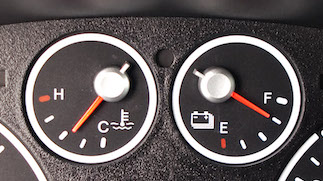
4 Main Reasons the Heating System May Not Work in Your Car
Maintenance is essential to any vehicle. It’s important that all parts of your vehicle are maintained properly. But what happens if your vehicle’s heating system is not working, even with proper maintenance? Here is how the heating system works and what might be to blame when it doesn’t.
How does a heating system work?

An electric car needs to use power from the battery to produce heat similar to an electric space heater. An internal combustion engine (ICE) vehicle produces heat as a byproduct of its primary function: propelling the vehicle. An ICE car produces lots of heat and must have that temperature regulated in order to remain in the desired range. The temp is regulated by way of a cooling system.
The car circulates coolant through the engine, absorbing heat. Once the coolant passes through the block, it flows through the cars radiator, where the heat is dissipated and circulated back through the engine, and the process begins again.
Some of this coolant can also be circulated through a radiator-like part called the heater core. The hot coolant flows through the radiator core while air blows through the core, giving you the sweet relief from the cold you crave, reports Haynes. Unfortunately, this delicate process can be thwarted by failing parts, just like anything else in your vehicle.
The problem can be the system itself
The system consists of a few essential components: the radiator, the heater core, heater hoses and clamps, the thermostat, and the fan. All of these components are liable to fail, and each failure can cause its own issues.
If the radiator leaks, the hoses are seeping, or the clamps aren’t tight; the system can lose coolant. If the system loses enough precious liquid, there may not be enough to travel to the heater core. Unfortunately for you, this will result in a noticeable lack of heat from the vents.
If you are not getting any heat in the cabin, topping off the system to allow the coolant to travel to the heater core could be a simple fix. However, if you don’t fix the main cause of the leak, this is only a temporary solution, so make sure to replace any hoses, clamps, or other defective cooling system parts for a permanent fix. One particular issue that escapes
What broken parts can rob you of heat?
In addition to more visible causes like leaks from torn hoses or a cracked radiator, some failures are not quite so obvious. In fact, some failures are internal and can’t be seen at all. Perhaps the most common hidden issue has air in the system. Air can be introduced into the system and can not only cause your heat to stop working but can also put your engine at risk for overheating.
Similarly, the thermostat can get stuck in the open position. If this happens, the system will be fully open and can prevent the car from reaching operating temperature resulting in lukewarm air—not ideal if you live in a state that experiences cold winters.
Another climate control component to keep in mind is the heater valve/blend door actuator(s). These flaps open and close depending on how hot or cold you set your climate control. On most modern cars they are electronic components and are worth testing before moving on to more expensive repairs.
The expensive stuff
If you are not getting heat in the cabin and your cooling system is in good shape, you may be in need of a new heater core. The heater core is a radiator that lives in your dash. Hot coolant from the engine circulates through the core, and air is blown through it via a blower motor.
Sometimes the core is simply clogged. This is the best case scenario. Without spending an arm and a leg, you can force water through the core to break up those clogs and potentially solve the issue. If not, replacing a heater core can be very expensive as it typically requires tearing apart the dash. The same can be said for the blower motor, which is responsible for blowing air into the cabin. Typically, shops like to replace both simultaneously because each can only be accessed by dismantling the dash.
Always start with the cheap fix
A car’s heating and cooling system are like a complicated ecosystem. Each part requires other parts to work properly to be effective as a whole. No matter what, be sure to inspect and test all components of the system before opening the wallet for big repairs—you just might get lucky.


